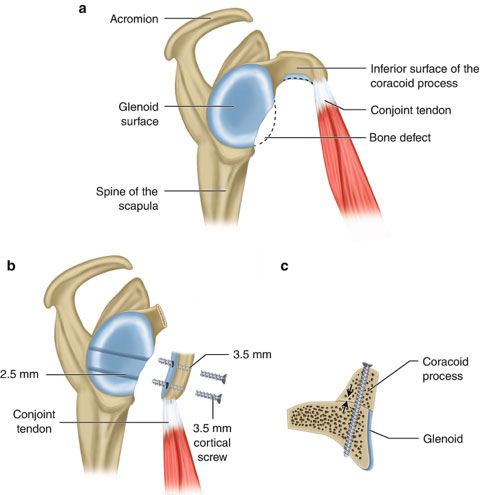Shoulder Instability – Laterjet Bone Block Procedure (Coracoid Process Transfer)

Altintas B, Godin JA, Millett PJ. Anterior Instability with Bone Loss: Latarjet Procedure. In: Millett PJ, Pogorzelski J, eds. Advanced Techniques in Shoulder Arthroscopy. Springer International Publishing; 2019:131-139. doi:10.1007/978-3-030-13503-4_13
What is it : If you have recently experienced instability in your shoulder or even a dislocation (or several), you may be at risk of re-dislocating. The research shows the rate may be as high as 80% chance of re-dislocating the shoulder after your first dislocation if you are <18 years old. You will likely have an MRI scan if experiencing an unstable shoulder and this usually shows an injury to the labrum (cartilage layer around the shoulder socket) or the bone of the shoulder socket itself (glenoid). The latter is called a bony bankart lesion.
Management : Due to the high re-dislocation rate after a first-time dislocation, there is limited non-surgical management. If you can avoid any above head activities or impact sports then your chance of dislocation may be reduced. In saying that, most of us want to be able to carry on playing the sports we love. The operation with the lowest re-dislocation rate is called a laterjet procedure where a bone near the shoulder joint is cut and moved to create a stronger barrier to stop the shoulder from dislocating. This is done using a cut at the front of the shoulder and the bone block is held in place with two screws. The laterjet procedure works very well in preventing future dislocations and will enable you to play impact sports again once it has healed.
Post-operative : After the laterjet procedure, you will be placed in a sling for comfort. You will be allowed to take your arm out of the sling and start moving it as comfort allows. At the 3-month mark, you will get a CT scan to assess for healing of the bone block. If this has healed then you will be able to go back to sport. Despite having this operation, there is always a risk of re-dislocating your shoulder.